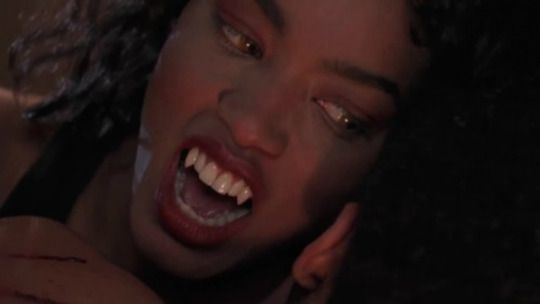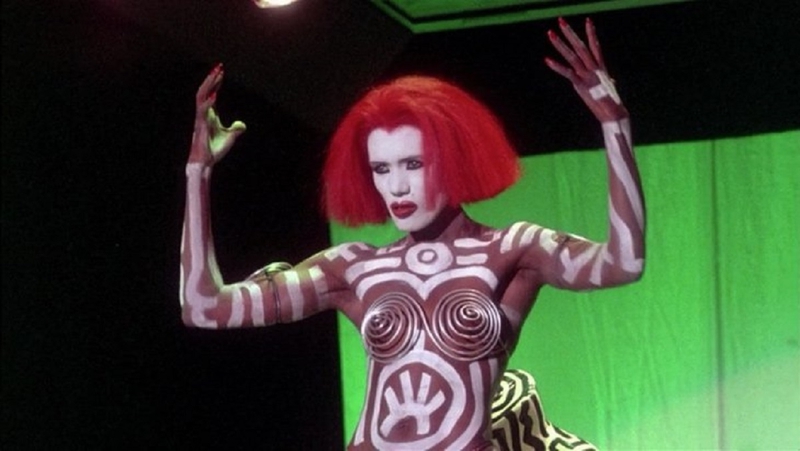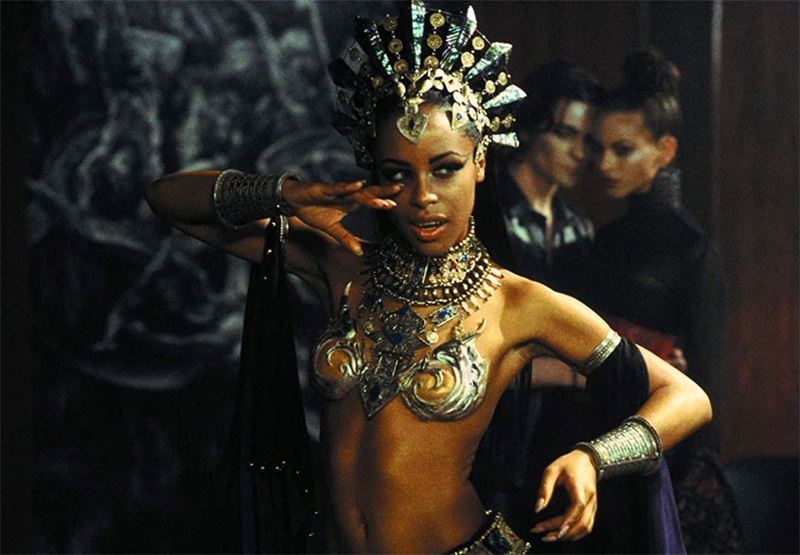With the long-awaited release of Nia DaCosta's Candyman finally imminent, it felt only appropriate to return to the subject of the Black vampire, if only because the film will undoubtedly raise inevitable questions about Black monstrosity. Candyman may be a ghost, but the film is equally about the monstrousness prescribed to Cabrini-Green, and neighborhoods like it—that monstrousness being predicated on perceptions of social parasitism and the mutual demonization and infantilization of the poor.
In the first part of this column, I wrote about the 1819 story, The Black Vampyr: the very first vampire narrative penned by an American author, and an abolitionist one to boot—though, to be clear, a nineteenth-century abolitionist text is very different from and cannot be equated with the cause of modern-day abolition. Likely written in response to slaveowner anxieties following the success of the Haitian Revolution in 1804, The Black Vampyr is a narrative that caters to the white gaze, was likely inspired by misinterpretations of African spiritual practices and folklore, and is structured to incite fear of an empowered, vengeance-motivated Black monster in its presumed white audience.
Set in Haiti, the story tells of an enslaved child murdered multiple times by a vicious slaveowner, Personne. Despite many attempts, the child continues to resurrect. Eventually, he escapes, sets a fire to kill Personne, and kidnaps his son on the way out. Years later, the two return, the slaveowner's son in service to "the Moorish prince," who seduces his charge's mother, turns her vampire, unites the enslaved mortals and immortals of the island, and leads a revolt against the slaveowners. Their rebellion proves unsuccessful and, at the story's close, white sovereignty is reestablished to ease the fears of its white readership. Over two hundred years and an entirely new medium later, the same tensions fuel the unique challenge presented to Black horror creators: if part of our oppression includes the strategic rendering of us as nonhuman- in effect, rendering us social monsters- how to depict a Black monster that avoids reification of anti-Black narratives?
The result is that the vampire films conceived of, written, and directed by Black people tend to make this theme and struggle their core considerations. Blacula, Scream Blacula Scream!, Ganja and Hess, Def by Temptation, Vampire in Brooklyn, and Suicide By Sunlight are all projects ultimately concerned with questions about good and evil, morality, and what that means within an imperialist white supremacist capitalist patriarchal society. While they all feature some variation of a Black vampire or vampire-like monster, there are key departures amongst this body of work- as well as 'Blacks in horror' films, Vamp and Queen of the Damned- not just in where/how they define monstrosity, but in the framing of the questions themselves, and the particular lexicons they operate within. What narrative patterns and intertextual conversations might be revealed when we examine these films in concert with one another, as entries in an ever-expanding tradition?

Vampire in Brooklyn
Written by Charlie Murphy and directed by Wes Craven, 1995's Vampire in Brooklyn is a film deeply influenced by-and clearly in conversation with- the Black vampire films of the seventies. Though several cues are taken from Blacula and a direct reference is made in its first act, Eddie Murphy's approach to Maximilian is almost antithetical to William Crain and William Marshall's rendering of Prince Mamuwalde. Vampirism, to Mamuwalde, is a loathed curse; his story is revolutionary precisely because it offers a vast departure from standard vampire lore. Conversely, Maximilian's construction draws more directly from Bram Stoker's Dracula as a source text.
The vampire first arrives in Brooklyn aboard a ship that crashes into the dock, the crew all found dead, drained of their blood. One of his first orders of business is to transform and enlist the help of a ghoul, Julius Jones (Kadeem Hardison), not dissimilar to a familiar tasked with his bidding. He's also a powerful shapeshifter, capable of transforming into a wolf, a cobra, the local preacher—all to find and seduce the dhampir daughter of a vampire from his home in the Caribbean (where in the Caribbean is never specified, and the fact that the dhampir mythology descends from the Balkans appears to be irrelevant).
This again mirrors Blacula as Mamuwalde pursues a beloved: his wife, Luva (Vonetta McGee), reincarnated as Tina. But where there's an undeniable romance within their story- as well as in Ganja and Hess- Max's pursuit of Rita (Angela Bassett), a detective we learn is the dhampir before she knows it about herself, is presented as overtly and singularly predatory. His "dance" of seduction is closer to the manipulations of an abusive partner or stalker as he strives to awaken the bloodlust within her and lead her to embrace her vampiric heritage.

Like Dracula, the battle between good (Detective Justice, Rita's partner) and evil (Max) occurs on the landscape of Rita's body, coded through their competing romantic desires—albeit with some notable departures. Rita has far more agency than either Mina or Lucy, and as a dhampir, her vampirism is not so much a matter of being turned, but of attunement with herself. As we learn, Rita's mother was an established scholar of the supernatural throughout the Caribbean and was institutionalized shortly following Rita's birth. According to Max, he was not only sent by her father, a vampire, to be her mate, but her mother's madness stemmed from the grief that followed his murder at the hands of vampire hunters.
Like countless projects before it- including The Black Vampyr- Vampire in Brooklyn casts the islands as mysterious and feral: a place that devours, and from which monstrous things emerge, keeping with a long fetishistic colonial history that far predates the early nineteenth century. After all, etymologically speaking, the very word "Caribbean" derives from the Spanish, "canibal," or cannibal, a name predicated on the conquistador's perception of native people as flesh-eaters.
Both Max and Justice (a joke, of course, naming a cop "Justice") attempt to persuade Rita to their polarized causes through claims of belonging or unbelonging. Max believes she'll be happier, freer as a vampire; Justice, that she's "not a killer" and "doesn't belong in [Max's] world." In the end, she overcomes her hunger, denies her parents' desires and her own heritage, and vanquishes Max.
The film's conclusions, as such, bear closer resemblance to Def by Temptation, or even 1974's Abby- otherwise known as "the Black Exorcist"- both of which also privilege Christian lexicons and hereby locate monstrosity in Black folks' cultural roots. The Black Church plays a very specific role in Vampire in Brooklyn, and Murphy's performance of Max-in-the-shape-of-Preacher Pauly is indeed hilarious for how it picks at the scabs of certain hypocrisies. Nevertheless, Rita's faith is continuously called upon to see her through. After Max is gone and the glamour over Julius' apartment lifted, she finds the gold cross necklace he'd torn from her earlier. Symbolically, her rejection of Max, her vampirism, and heritage signal her return to Christ.
If we accept Christianity has historically been a tool of colonial white supremacy- that African spirituality has been strategically demonized within the popular imagination for centuries- what then are the implications of her rejection? How is this compounded when we consider the enmeshment between her identity and career as a cop, her refusal to feed on Justice, and her symbolic choice of his partnership over Max's? Further, what does their alignment- the church and the police presented as forces of good- tell us about who this film was made for?

Vamp & Queen of the Damned
Rita's refusal marks a stark departure from earlier treatments of vampirism and Black femininity, most notably Bill Gunn's Ganja and Hess, in which Ganja thoroughly embraces her various hungers along with immortality as a gesture toward empowerment. Because the world treats her as a monster for profoundly human desires, she finds freedom in monstrosity's embrace, outside the prescriptions of supremacist society—ideas also demonstrated through Valentina (Natalie Paul), from Nikyatu Jusu's 2019 short, Suicide by Sunlight. As in Ganja and Hess, the film's duration is a meditation and recalibration of the prescriptive nature of morality. While Ganja and Hess, as individual characters, arrive at vastly different conclusions regarding their vampirism, the questions the film raises are not so much meant to disseminate specific ideas about morality but rather to trouble the lexicon itself. Whose definition of right and wrong, good and evil, does a given project privilege?
That said, swing this method too far in the other direction, and you wind up in some messy territory. It's likely Ganja and Hess bore some influence on Vamp, if only in terms of wielding vampirism as a metaphor for addiction. The inimitable Grace Jones plays Katrina, the alluring, confounding, and ruthless star seductress of the After Dark strip club's nightly show. While she is, without doubt, the film's villain, she's also the only reason to watch it in the first place—and her character utters nary a sentence!
In peak absurdist '80's horror fashion, Vamp follows three college boys' quest to find a stripper as part of their fraternity indoctrination. Underage and inexperienced, they find themselves at the After Dark, utterly seduced by Katrina's now-iconic stage performance, a sort of high art-high camp facsimile of burlesque that is, nevertheless, utterly enchanting. When AJ (Robert Rusler), the cockiest and most ambitious of the three, decides he'd like to purchase her for the evening, he winds up being her post-performance snack. As it turns out, the After Dark is run mainly by vampires, Katrina the dominant among them. In fact, the entire downtown area where the club is located teems with them.
Vamp is, in short, a glaring reflection of '80's attitudes toward the disenfranchised, quite literally casting sex workers and residents of low-income neighborhoods as vampires, feeding on the lifeblood of the upper class. Their coding, as such, cast people of color, the poor, those experiencing addiction, or whose labor is simply stigmatized as the occasion of The Swallowing. The racist, classist stereotyping is so heavy-handed that I sometimes feel Patrick Bateman himself could have written this film. At the same time, I have never been more down for anything than Grace Jones as a vampire madame to a bunch of vampire strippers.
With some minor tweaks in concept and perspective, Vamp could have been (or could be if anyone wanted to fund a remake) truly fucking great. The film's treatment and prejudicial bias ultimately limit its potential and make it the type of problematic representation that begets respectability-driven characters like Rita.
Then there's Akasha, the ancient mother of vampires famously portrayed by Aaliyah in 2002's Queen of the Damned. Awakened by Lestat (Stuart Townsend) after a millennia of stone sleep, he and Akasha share a mutual longing for partnership, freedom of movement, and, of course, blood. Though vastly different in style and performance, Aaliyah does take after Jones in that she conjures a similarly irresistible captivation in her onscreen subjects that extends to her real-life audience—necessary in a film propelled primarily by its melancholic nu-metal goth vibes. Their characters share a fondness for ripping out hearts. Along with The Temptress (Cynthia Bond) from Def by Temptation, they demonstrate none of the subtlety or moral quandaries that plague Rita, Ganja, and Valentina. To Akasha, "humans are animals," "brute creatures" whose "destruction can only make sense." Her sole sentimentality is directed toward Lestat, to whom she is downright doting and who she repeatedly refers to as "[her] king."

While this may be more thematically overt in Vamp, Akasha's devastation of an entire island in a single evening- and Lestat's horror when he awakes to this "kingdom of corpses"- undoubtedly point to anxieties around overconsumption. And like Katrina and The Temptress, this is her only characterization. No more complex than that. An ancient monster obsessed with her male partner who must be annihilated before she drains us of all we have to offer: a hyperbolic rendering, essentially, of the welfare queen.
In the end, Lestat double-crosses Akasha, and she is drained and vanquished by her children. From this ending, we are meant to analyze the nature of motherhood, creation, and what we owe to the world and future generations.
Akasha is something close to a god-like representation of The Swallowing: ancient and in possession of a degree of power that threatens to devour both the world and the future—her children's justification for why they must destroy her. She's also a manifestation of some very specific archetypes that hail from very specific lexicons. Jung would call her the devouring mother, Barbara Creed, the archaic or monstrous mother: one who allures and devours, whose hunger and desire for enmeshment must be contained lest it consume the world.
In essence, Vamp, Queen of the Damned, Def by Temptation, and Vampire in Brooklyn reinscribe notions of Black monstrosity predicated on a moral binary designed and constructed at our explicit exclusion. While the latter two, as Black Horror productions, attempt to universalize prescriptive moralism through the lexicon of the Black Church, in doing so, they reveal the trouble with the framework itself. No matter how you try to bend them, lexicons predicated on equating Blackness with deviancy will only result in narratives that suppress and pathologize our human hungers and desires. In many ways, Ganja and Hess, Suicide by Sunlight, Blacula, and Scream Blacula Scream!, through embrace of their Black monsters and all their glorious complexity, embrace the complexity of our human experience.






